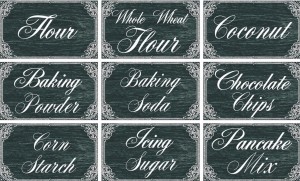Have a look in your pantry. In your fridge. On the boxes and bottles in your medicine cabinet. I bet everything has a label on it.
You don’t want to end up icing your cake with flour. Or putting salt into your coffee instead of sugar. I certainly want to make sure that I’m spreading my toast with sweet apricot jam, not spicy mango relish! Is anaphylaxis an issue? I bet you read the fine print on the labels carefully.
We label for a reason. Information on labels can range from the important (what the item is, use-by date, ingredients) to the more banal (depending on your perspective). Labels give us important information about safety and storage procedures, how to use the product, provenance, purpose, nutritional information – the list goes on.
Laws regulate labelling precisely because we rely on the accuracy of the information they provide. Yet somehow, when it comes to our children, the last thing we want is for them to be “labelled”. Why is this?
Over the years I have spoken with many parents whose children struggle with aspects of school. Yet they don’t want to alert the school to their kid’s diagnosis for fear that the child is “labelled” – by which they mean, “stigmatised”. Sometimes neither parent wants the condition known, but in my limited experience, it often seems to be the father who finds it hardest to be open about his child’s differences. So the parents’ task becomes one of describing the child’s strengths and challenges without using the term “Asperger’s”, or whatever it is. So many of us do this. But in the end, are we really helping our children when they are most in need?”
I have been thinking about this issue on and off for over 16 years now, ever since Wombat Dad and I realised that our daughter was not at the low end of the developmental bell curve because she was a slow developer. It was because, among other things, she has autism.
Back then, we knew nothing about autism. But as we began to climb that fairly steep learning curve, we started to gain an insight into some of the struggles our then nineteen month old daughter might have been facing. We also began to learn about strategies we could put in place to support her. This led to early intervention, speech therapy, physiotherapist, PECS (communication) cards and a range of other things. We adapted our approach and our thinking – and are still adapting! – to enable our little Wombat to adapt to the world around her.
The label “autism” was useful for us, and useful for others – educational staff, family and friends. It helped us to be patient, to set realistic (NOT limited) expectations for her, and to put in place the supports she needed to reach her goals. And yet … And yet…
Even at early intervention, I was aware that some parents were reluctant to openly acknowledge their child’s condition because they felt it would stigmatise their child – even when that child had obvious special needs.
I can empathise with this. As parents and careers, we don’t want our kids stigmatised, or limited, because they have an identified special need. We worry, often legitimately, that people won’t see past the label to the child. But I wonder, sometimes, if in our anxiety for our kids not to be stigmatised, we actually deny them the chance to get the support they need.
My 10 year-old niece has diabetes. It is critical that her teachers know this, know about her need to monitor her blood sugar levels through the day and have her insulin injections, and to be aware of the signs of a hyper or hypo-glycemic reaction. Her life might depend on it. Why should it be different with special needs kids, really?

Yet somehow, especially when it comes to high-functioning kids, we are often more reluctant to be public about their condition. I know that was how we initially felt about Train Wombat’s Asperger’s diagnosis. We didn’t want him to use it as a reason to avoid work, or as an excuse for poor decision-making. We wanted him to be stretched, not confined, and were worried at first that a diagnosis might pigeon-hole him. On top of this, he didn’t want the diagnosis widely known. Fair enough. So we kept it quiet – at first.
It came to the point with us, however, when we felt the benefits of having Train Wombat’s condition known by the teaching staff outweighed what we perceived as the disadvantages. We spoke to him about this, and he reluctantly agreed. It certainly made a difference to the teachers’ understanding of his behaviour, including some of the triggers for poor behaviour, his need to sometimes seek “time out” when multiple sensory inputs became overwhelming and realising that he had a very literal, black-and-white view of the world.
I wonder whether also it helped our son to understand better why he saw the world in a different light from many of his peers, and why some things which came easily to others (like making friends and reading social cues) were so much harder for him. One day in class, when autism was mentioned in the context of a discussion about a class novel, he announced to everyone, “I have autism.” We were really proud of him for being so brave in his openness. It showed he had taken a significant step in understanding and accepting this part of him.
Over the next couple of years, while life was certainly far from easy for our Wombat, the school was extremely supportive. They could see that we were playing a long game, and had to “hang in” through the tough times. They could see his potential, and made every effort to be flexible around work expectations, developing safety plans and being extremely supportive to us as parents and him as a “work in progress”.
Also, as other parents and friends in our wider circle became aware of his condition, it helped them to understand that some of his behaviour was not “naughty”, but that there were other factors behind it.
I really believe that the more we are open about the challenges our kids face, the more others are able to come on board, develop their own understanding and be more accepting and supportive. After all, one day our kids will be out of school studying, working, volunteering, raising families, being part of the community. And how do we create community? Through building links with each other – and those links are built through understanding.

It’s a really personal decision. I’ve been in both camps – labelling and not labelling. But overall, knowledge is power. And surely, all of us want to empower our children.



